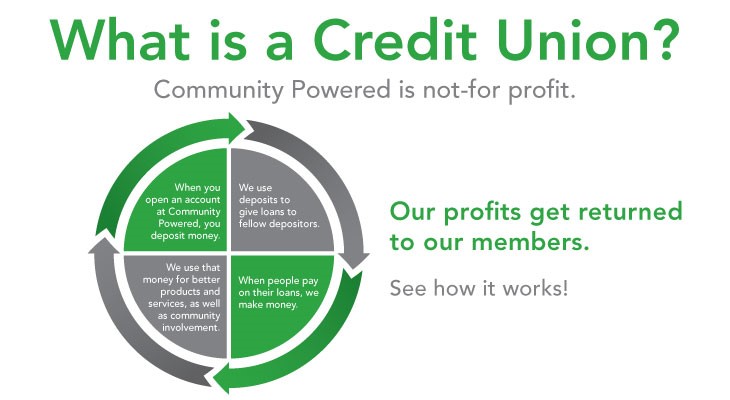The Ultimate Overview to Recognizing Debt Unions

Credit unions stand as distinct economic entities, rooted in principles of common support and member-driven operations. However, past their fundamental worths, recognizing the intricate workings of credit report unions involves a deeper exploration. Deciphering the intricacies of membership qualification, the advancement of solutions offered, and the distinct advantages they bring calls for a thorough exam. As we navigate via the ins and outs of credit report unions, an insightful trip waits for to clarify these member-focused establishments and exactly how they differ from standard financial institutions.
What Are Cooperative Credit Union?
Lending institution are member-owned monetary establishments that provide a series of banking services to their members. Unlike standard banks, cooperative credit union operate as not-for-profit companies, indicating their key emphasis gets on offering their members rather than making the most of profits. Participants of a cooperative credit union normally share an usual bond, such as functioning for the very same company, coming from the exact same area, or becoming part of the very same company.
One of the crucial benefits of cooperative credit union is that they often offer higher passion prices on interest-bearing accounts and reduced passion rates on financings compared to banks. Credit Unions in Wyoming. This is because lending institution are structured to profit their members straight, enabling them to hand down their earnings in the kind of far better prices and fewer costs. In addition, debt unions are understood for their customized customer care, as they prioritize constructing relationships with their participants to understand their unique financial demands and goals
History and Development of Lending Institution
The roots of member-owned monetary cooperatives, recognized today as cooperative credit union, trace back to a time when neighborhoods looked for alternatives to standard financial institutions. The principle of lending institution originated in the 19th century in Europe, with Friedrich Wilhelm Raiffeisen usually attributed as the pioneer of the participating financial activity. Raiffeisen established the first acknowledged lending institution in Germany in the mid-1800s, stressing area assistance and self-help principles.
The evolution of credit report unions continued in The United States and copyright, where Alphonse Desjardins established the first cooperative credit union in copyright in 1900. Shortly after, in 1909, the very first united state lending institution was created in New Hampshire by a team of Franco-American immigrants. These early credit unions operated on the basic concepts of common assistance, democratic control, and member ownership.
Over time, cooperative credit union have grown in popularity worldwide due to their not-for-profit framework, concentrate on offering participants, and providing affordable monetary services and products. Today, lending institution play a crucial duty in the financial sector, supplying available and community-oriented banking options for individuals and organizations alike.

Subscription and Eligibility Requirements
Membership at a debt union is usually limited to individuals meeting particular eligibility criteria see post based on the institution's founding principles and governing demands. Some credit history unions might just offer individuals that function or live in a certain area, while others may be customized to employees of a particular company or participants of a particular association.
Additionally, credit unions are structured as not-for-profit companies, indicating that their primary goal is to offer their participants instead of generate profits for shareholders. This concentrate on member solution typically equates right into more tailored interest, reduced fees, and affordable rate of interest on fundings and financial savings accounts. By fulfilling the qualification criteria and becoming a participant of a credit history union, individuals can access a range of monetary products and solutions customized to their certain demands.
Solutions and Products Provided
Among the key elements that sets lending institution apart is the varied series of economic product and services they use to their members. Credit history unions commonly give standard banking services such as financial savings and checking accounts, fundings, and credit cards. Participants can also gain from investment solutions, consisting of pension and financial planning aid. Many lending institution use affordable rate of interest on savings accounts and financings, in addition to reduced fees contrasted to traditional banks.
Furthermore, lending institution typically supply convenient online and mobile banking options for members to quickly handle their finances. They might supply rewards such as shared branching, allowing members to access their accounts at various other lending institution next page throughout the nation. Some cooperative credit union likewise offer insurance products like auto, home, and life insurance to assist members safeguard their assets and useful site enjoyed ones.

Advantages of Financial With Lending Institution
When thinking about monetary institutions, discovering the advantages of financial with credit report unions discloses special benefits for participants seeking personalized solution and competitive prices. Unlike huge banks, credit scores unions are member-owned and focus on structure strong partnerships with their participants. In general, banking with a credit scores union can provide a much more personalized, cost-effective, and member-centric economic experience.
Final Thought
To conclude, cooperative credit union stand apart as member-owned banks that prioritize offering their members over optimizing earnings. With beginnings dating back to 19th century Europe, cooperative credit union adhere to concepts of mutual support and participant possession. They offer a variety of economic product and services, including conventional banking services, financial investment options, and competitive rates of interest. Subscription qualification criteria specify and mirror a community-oriented approach, providing individualized customer solution and a member-centric economic experience.
Debt unions are member-owned economic establishments that supply a variety of banking services to their members. The principle of credit unions stem in the 19th century in Europe, with Friedrich Wilhelm Raiffeisen often attributed as the leader of the participating financial movement.The advancement of credit history unions continued in North America, where Alphonse Desjardins developed the very first credit scores union in copyright in 1900. Credit scores unions typically provide traditional financial services such as financial savings and inspecting accounts, car loans, and debt cards.When thinking about financial establishments, exploring the benefits of banking with debt unions exposes one-of-a-kind benefits for participants seeking individualized service and competitive prices.